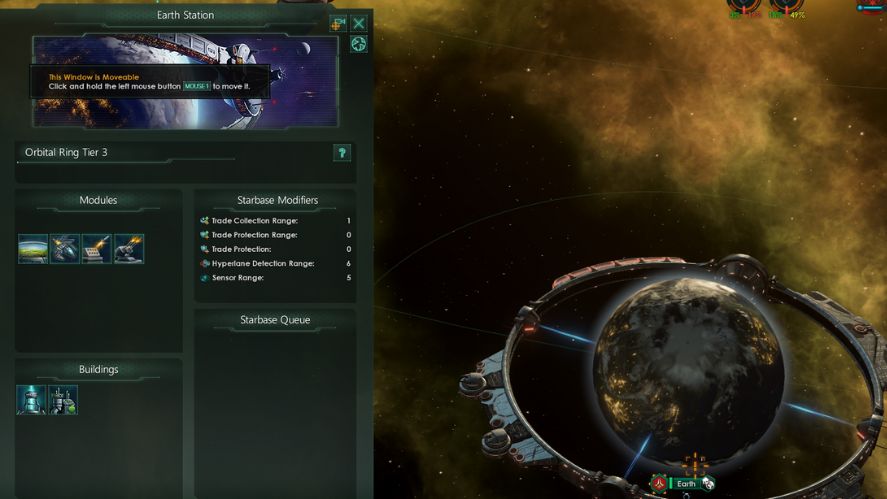A large complaint the Stellaris community has is that once you reach the mid-game, Starbase power level takes a bit of a nose dive. They are not able to keep up with the fleet power levels.
This makes investing in weapons for your starbases a waste of resources because they will never be a challenge to your enemies. The Orbital Ring megastructure is the only support your starbase can get, other than direct fleet support.
Recommended Read: How to Assimilate in Stellaris
Paradox saw fit to introduce Orbital Rings with the Overlord DLC, which you will need to own before you can build one. This guide will teach you everything there is to know about Orbital Rings in Stellaris.
To build an Orbital Ring in Stellaris, you will first need to unlock the Orbital Rings Technology. After doing this, building takes place around any colonized planet, using a construction ship. The only caveat is that it must be within your own borders.
Table of Contents
How to Build an Orbital Ring in Stellaris
Orbital Rings are a strange entity within the game. Is it a starbase? Or is it a megastructure? Well, the truth is, it is both.
Features they share with starbases are: they are a last line of defense against attackers, it is where defense platforms operate from, you can build starbase modules on them, and you can also build starbase buildings.
Traits they share with megastructures are: that they are expensive, they take a lot of research, are built by a construction ship, and they are very big.
Their role in your empire is twofold: they are a defensive structure, and they provide special bonuses to the planet they orbit.

Compared to other megastructures, their construction is much easier. Before you can start your first one, a few things must be true first.
There are three research projects that prelude the creation of an Orbital Ring. These are; Starhold, Ceramo-Metal Infrastructure, and Galactic Administration.
These are all young mid-game technologies and none of them are rare, so this should be no bother.
The aforementioned techs are the precursor to the Orbital Rings technology project. Without them, you won’t be able to research Orbital Rings.
Again, Orbital Rings are not a rare technology, so there is no need to optimize your empire to get a chance at this.
When you complete the project, you are free to begin your first Orbital Ring.
Building your First Orbital Ring
With the passive section of construction complete, it is time to set your engineers to work on building your first Orbital Ring.
If you are lucky, you can unlock this technology really fast and set yourself up with some formidable defenses early. Very useful if you have genocidal neighbors and they think your species looks delicious.
You will already have two of the three things that you need to build the Orbital Ring: a construction ship and a colonized planet. The third thing you need is the resources to pay for it.
There’s more good news first, Orbital Rings are the cheapest and easiest megastructure project. The first stage will only cost you 1000 alloys, 50 influence, and 720 days.
Unlike other megastructures, there is no construction site phase. Once your construction ship finishes the work, the Ring is ready for use.
The first stage of construction is choosing a colonized world for it to orbit. Your home planet will do fine, or any other one you may have claimed while playing up to this point.
After deciding, send a construction ship to the system that contains the planet. Once it gets there, select the ship again and choose the build megastructure icon on the ship interface menu.
This will bring up the megastructure menu. Select Orbital Ring from the list, and you will then left-click on the planet you want the orbital ring built around.
You will know it is a valid selection because the planet will display a green marker around it that looks like a target.

Your construction ship will begin the building work, and after 720 days have passed, you are now the proud owner of a brand new Orbital Ring.
Why Build Orbital Rings
Unlike other megastructures, which only allow you to build one of each type, you can build as many orbital rings as you have colonized worlds.
If you build one of these around every planet, the bill could get quite high. So, should you?
If you are building them to defend your systems from invasion, I’m sorry, but these are not going to save your system from any substantial threat.
The increased fire rate and weapons range bonuses can be very useful at earlier stages of the game. The problem is that their power level has a hard cap, and fleets won’t take long to surpass this limitation.
There is one niche case that a lot of players endorse. They are great for a turtle-style defense.
What this technique involves is situating your fleets in a choke point system and forcing your enemies to come through with all your fleets waiting for them.
With an orbital ring, and a starbase in support of your fleets, your ships will be enjoying some tasty buffs to their power level. This is a great strategy for buying time against the end-game crisis.
The primary reason you want orbital rings is for their planetary bonuses, not their military application.
These bonuses can increase resource production from jobs, create extra jobs, provide more envoys, increase trade value, and even help keep slaves in line.
Given time, these production bonuses will ensure the ring pays for itself in no time.
The best way to make use of Orbital rings is to treat them like a long-term background project. Methodically adding them to your planets, as and when your current resources allow for it.
Once your empire reaches the post-scarcity phase, go nuts and start building them everywhere to help feed your economy further.
Upgrading Orbital Rings
Like starbases and other megastructures, Orbital Rings can benefit from upgrades.
These upgrades provide: more module slots, more building slots, more weaponry, more defense platforms, increased weapons range, and more hit points.
To get the most out of your orbital rings, you will want to upgrade them. There are two extra tiers you can upgrade your rings to. This will need some research and the planet quality to be high.
The tier two upgrade needs the Star Fortress technology unlocked. Also, the planet it orbits must have an ascension tier of three or two if it is your capital.
It will also cost you 1500 alloys, 100 influence, and 900 days to complete.
Tier three orbital rings require the Citadel technology. On top of that, the planet’s ascension tier must be at level five or level three if it orbits your capital.
The resource cost will be 2000 alloys, 150 influence, and 1080 days of in-game time to finish construction.
Upgraded orbital rings are the only way to get hold of the valuable resource production buildings for your planets.
This is the primary strength of orbital rings, so don’t forget to come back and upgrade them as you progress through your game.
This is everything you need to know about Orbital Rings in Stellaris.
If you have any questions or suggestions for this guide, please let us know in the comments section below. As always, have fun building your Orbital Rings in Stellaris.




